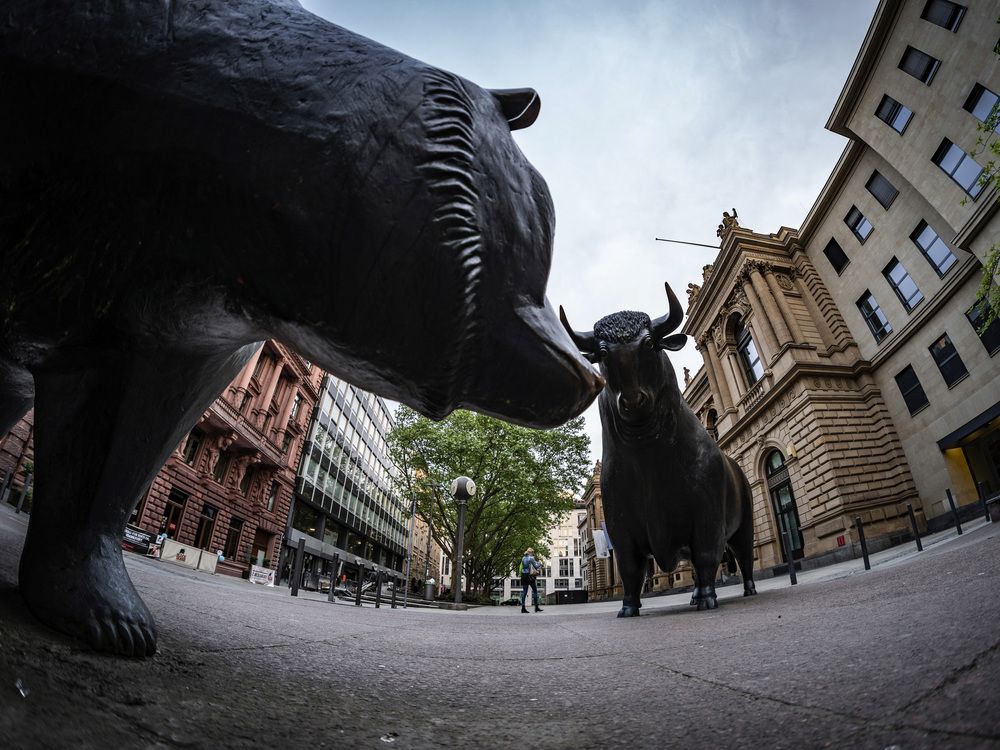Recession bear markets don’t end until the tail end of the Fed easing cycle, which is increasingly looking like a 2024 event
A bear statue faces a bull statue outside the Frankfurt Stock Exchange. Photo by Peter Juelich/Bloomberg The countertrend market rally really took off in the middle of June. Why? Because that was when the markets started to believe the United States Federal Reserve, by frontloading the rate hikes, was blazing the trail for an earlier pause and pivot, something reinforced by taking chair Jay Powell’s subsequent comments regarding “data dependency” to mean the potential for a pause.
Advertisement 2 This advertisement has not loaded yet, but your article continues below.
It was then that Mr. Market began to price in two full rate cuts for 2023. The 2/10 yield curve was positively sloped to the tune of 13 basis points, and the U.S. dollar strength began to subside. High-yield spreads began a period of compression as visions of a soft landing danced through everyone’s minds. And 10-year real yields, the poster child for financial tightening, embarked on a two-month slide from 63 basis points to 36 basis points just the other day.
But, alas, there are many at the Fed who are stepping out and sounding more hawkish than the chair and more than the tone of the published set of Federal Open Market Committee (FOMC) minutes. No, no, no. The Fed is not done, and some are openly stating that they are ready to vote for another 75-basis-point hike at the Sept. 20-21 meeting.
Advertisement 3 This advertisement has not loaded yet, but your article continues below.
Just as the S&P 500 tested its 200-day moving average, reversed 50 per cent of the bear market decline in the first half of the year, and saw more than 90 per cent of its members rise above the 50-day trendline (not to mention the CNN Fear & Greed Index moving into the Greed column), the index has now hit the wall. No kidding. A near three-point P/E multiple expansion in two months’ time doesn’t exactly happen every day.
History rhymes. Remember that
Also keep in mind that since the June lows, four stocks have done the heavy lifting for the S&P 500 — Apple Inc., Microsoft Corp., Amazon.com Inc. and Tesla Inc. Together, these companies comprise an 18-per-cent share of the index (based on market cap), but have explained 30 per cent of the returns. This speaks to lopsided participation and is not a healthy sign — this is a great example of Bob Farrell’s Market Rule No. 7: “Markets are strongest when they are broad and weakest when they narrow to a handful of blue-chip names.”
Advertisement 4 This advertisement has not loaded yet, but your article continues below.
But now the real interest rate is on the rise. High-yield spreads are starting to widen again. The U.S. dollar is beginning to firm. Profit estimates are coming down, and guidance is generally poor. Global demand is clearly fading as the Commodity Research Bureau (CRB) index was sitting at 625 at the mid-June FOMC meeting and is down to 588 today. And the futures market is fearing the Fed again, because those high hopes of a 2023 easing cycle resuming have fallen by the wayside — now giving just 65-per-cent odds for one cut and not until the end of next year.
More On This Topic David Rosenberg: Look under the hood and what do we see? An earnings recession David Rosenberg: Five reasons we haven’t seen market bottom yet David Rosenberg: Roof is about to cave in on the Canadian economy David Rosenberg: Cyclical sectors next ‘shoe to drop’ — and the TSX is especially vulnerable This advertisement has not loaded yet, but your article continues below.
Article content History rhymes. Remember that. And true fundamental lows in the stock market tend to occur after the last Fed rate cut, not the first one. The rally after the pause and the rally after the first easing are always head fakes. Stock markets bottom when the Fed has eased aggressively enough to take the 2/10 curve to +140 basis points on the average and on the median. The futures market is now saying this first rate cut doesn’t happen until late 2023, so how is it even possible that the S&P 500 bottoms this year or even next?
The refrain “don’t fight the Fed” works in both directions. And recession bear markets, to reiterate, don’t end until the tail end of the Fed easing cycle, which is increasingly looking like a 2024 event.
Play the long game by being patient, being nimble, since intermittent rallies will come and go, and focusing mostly on capital preservation. The ultimate lows and next fundamental bull market could well be two years away. Think 1973-75, think 1980-82, think 2000-2002 and think 2007-09.
David Rosenberg is founder of independent research firm Rosenberg Research & Associates Inc. You can sign up for a free, one-month trial on Rosenberg’s website.
_____________________________________________________________
If you like this story, sign up for the FP Investor Newsletter.
_____________________________________________________________
Financial Post Top Stories Sign up to receive the daily top stories from the Financial Post, a division of Postmedia Network Inc.
By clicking on the sign up button you consent to receive the above newsletter from Postmedia Network Inc. You may unsubscribe any time by clicking on the unsubscribe link at the bottom of our emails. Postmedia Network Inc. | 365 Bloor Street East, Toronto, Ontario, M4W 3L4 | 416-383-2300
